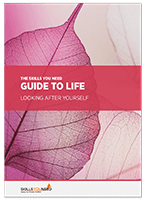The Grounding Technique:
How to Cope with Overwhelming Thoughts & Emotions
See also: Mindfulness
If you’ve been feeling overwhelmed by your thoughts and feelings recently, know that you are not alone. Being consumed by distressing or intense emotions is a natural response to high stress or anxiety.
Whether it’s a gnawing sense of internal dread that persists over time or a mighty full-blown panic attack that sucks the breath out of your lungs, anxious thoughts and feelings are potentially debilitating. Especially when they’re left to run rampant over our mental and emotional health.
Many people are familiar with these uncomfortable states of mind, which can often leave us feeling restless and agitated, unsure of how to reclaim inner calmness and contentment. In times such as these, it’s helpful for all of us to be equipped with the right tools for bringing ourselves back down to earth, firmly rooted, and in harmony with both mind and body.
Grounding is an exceptionally useful skill to learn. With it on your side, winding down from overwhelming thoughts and emotions can soon become second nature.
What Is Grounding and How Does It Work?
Grounding involves a set of simple strategies for calming the mind and detaching from destructive emotions or thoughts. It’s something anyone can do in any environment to let go of anxiety and bring yourself back down to earth.
Grounding can also be thought of as centering, practicing healthy detachment, or even as a form of meditation. Even though grounding might not solve the root of what’s causing the overwhelming emotions, it can help you quieten them before they get worse.
It’s a temporary method for controlling the thoughts, ideas, or emotions that make you feel overwhelmed. Grounding can act as an anchor for moments of distress, allowing you to grasp onto something in the midst of your internal chaos.
The main idea behind grounding techniques is that they involve physical movements, words, or a sensory activation that ultimately pulls you out of your anxious mindset and into your present body.
These actions give you something to focus on so that you are no longer under the destructive influence of anxiety-fueled thoughts and feelings. Grounding techniques require no special tools, and you can use them in almost any environment without attracting attention.
There are numerous scientific studies on the effectiveness of grounding for people battling with high stress, anxiety, or PTSD. Here are seven popular grounding techniques to try next time you start feeling overwhelmed.
1. Breathe Deeply
Breathing has been used as a calming and grounding technique since the dawn of mankind. Diaphragmatic breathing describes the deep, belly-filling inhale and audible exhale that helps to activate the vagus nerve and soothe the entire nervous system.
Deep breathing is an excellent grounding technique that tends to reach its peak effect after 4-5 breath cycles.
Studies suggest it is best to start by simply slowing down your breathing until it reaches a natural pace, then graduating to 4-second inhalations and exhalations. A pause in between each breath can also help to facilitate relaxation.
2. Repeat a Mantra
Some people have found that selecting a personal mantra to repeat in times of emotional or mental distress has positive effects. The mantra can be anything that soothes you in particular, but here are some commonly used suggestions:
Narration – Speak your name out loud, where you are from, and what your environment looks like. Try to observe small details around you and describe them as though you were talking to a friend on the phone. Focus on things you find beautiful, interesting, or calming to look at.
Affirmation – Short, soothing statements that make you feel safe or empowered. For example, I am loved, I am safe; I am grounded. I allow my emotions to move through me. I choose to release negativity from my body.
Recitation – Reciting a poem, book passage, or song that you know well can be very comforting. If you can’t think of any off the top of your head, keeping a favourite book or journal to read from can distract and soothe the mind long enough to move past unwanted thoughts or feelings.
The above techniques will appeal to those who are more prone to verbal expression. If you’re comforted by stories, songs, or poetry, this is a very effective grounding technique.
3. Stretch Your Body
A good stretch can help to release accumulated physical tension and give your body a welcomed wave of relaxation in times of emotional distress.
Simple stretches like reaching for the sky, rolling your shoulders or sitting in child's pose are all effective ways to occupy the body while you focus on that gratifying feeling of tension relief. If you suffer from mobility issues or even if you use a wheelchair, don’t let this stop you. Just consciously tensing and relaxing your muscles helps you to release tension.
4. Touch A Sensory Object
Interacting with unusual textures or sensory objects can help to distract your mind from intrusive thoughts and engage your sense of touch in an enjoyable way.
Playing with an ice cube, for example, can add the element of extremely low temperature to draw your attention away from abstract anxieties and into the present moment.
While holding the ice cube, encourage yourself to really explore every detail of what it feels like, how it looks, and how your hands feel when playing with it. This technique can work with any sensory object in your vicinity, such as rough tree bark, a cold shower, or even moldable clay.
5. Try The 5-4-3-2-1 Technique
The 5-4-3-2-1 technique has been in use for decades as a coping mechanism for people with low-functioning anxiety. In the event of feeling emotionally and mentally overwhelmed, following this numerical pattern can give your mind a structure to cling to instead of giving in to chaos.
5 – identify five things you can see. Notice their colors, shapes, and textures.
4 – Acknowledge four things you can touch. Allow your senses to envelope them.
3 – Notice three things you can hear. Notice the space between the sounds.
2 – Identify two things you can smell. Even if they are subtle like your skin or clothing.
1 – Become aware of one thing you can taste. Cereal? Coffee?
The point of this exercise is to bring your mind and body back into reality instead of hyper fixating on the thoughts or feelings that are making you anxious.
Anxious thoughts and feelings shouldn’t stop you from living your life or become debilitating. Knowing how to deal with overwhelming feelings is key to staying on track. With enough practice, anyone can use these grounding techniques to find their calm in the storm.
Further Reading from Skills You Need
The Skills You Need Guide to Life
This two-part guide is an easy-to-read summary of the essential skills you need for a healthy mind and body.
The first eBook, Looking After Yourself, covers some of our most popular content and will help you to live a happier, healthier and more productive life.
The second eBook, Living Well, Living Ethically, considers how you can live your best life all the time. It helps you to answer the question: how can I avoid having too many regrets about my life?
About the Author

Lina Becker started her career in education as a remedial teacher. In 2012 she became a freelance editor, working with various media outlets, covering topics ranging from education to productivity.
Lina is fascinated by people using their energy to grow into better versions of themselves and use their untapped potential.
Continue to:
Positive Thinking
Self-Awareness


